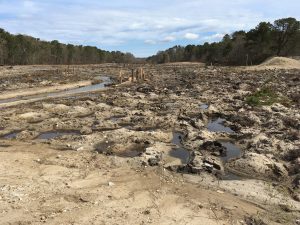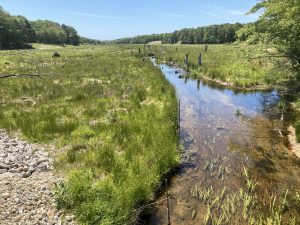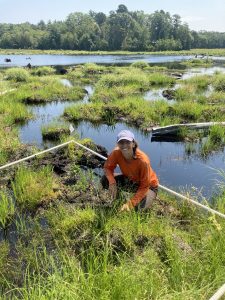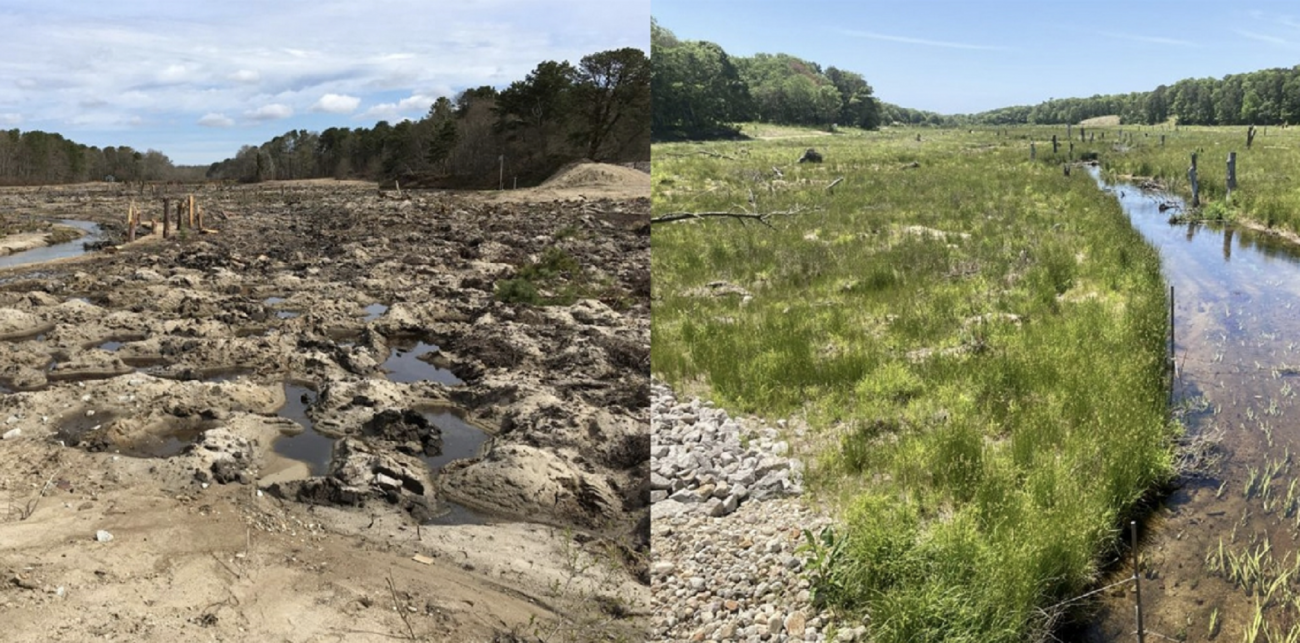Cranberry farming was once a prominent industry in southeastern Massachusetts, but now that the cranberry industry is shifting to other areas of the United States and Canada, many New England cranberry bogs are retiring, and efforts are underway to restore some of them as wetlands – a nature-based solution to a number of issues, from flood control to filters of environmental pollutants.
New England’s remaining cranberry farms are still concentrated in southeastern Massachusetts, where UConn College of Agriculture, Health and Natural Resources Department of Natural Resources and the Environment Ph.D. student Sarah Klionsky focuses her work studying restoration efforts that are increasing the number of wetlands in the region.

When cranberry farms were starting in the area, they were often built on wetlands. Though popularly referred to as “bogs,” Klionsky explains, these areas are usually not technically bogs in the botanical sense, and are more typically a type of wetland known as riparian fens. Restoration of the fens creates habitats for wildlife and plants, and a potential means to remove nitrates from waterways before they reach coastal estuaries.
Nitrates are nutrients, and in excess they lead to a problematic explosion in populations of fast-growing organisms like algae and bacteria, whose accelerated growth can deplete oxygen, resulting in devastating “dead zones” for marine and freshwater wildlife. Nitrates can originate from sources including agriculture and home septic systems, for example.
Determining if and how these restored wetlands remove nitrogen is vital information for future restoration efforts. If restored farms are effective nutrient absorbers, other restorations of retired farms could help increase the wetland area available to improve water quality.
Restoration is no easy task. Cranberry farming is different from tilled-soil farming, says Klionsky, and the methods can drastically alter the landscape and hydrology. Cranberry farms rely on water control features like dams and ditches, and every few years farmers add a few centimeters of sand to help suppress weeds and stimulate growth of the cranberry vines. Over the years, this leads to a thick, heavy layer of sand that compresses the peaty wetland soil below.
Restoration removes a small amount of that sand, but complete removal would be very costly and result in a much lower elevation due to the compression, creating open water instead of wetland, says Klionsky. Restoration also involves the creation of variations in microtopography – slightly higher and lower spots all over the site, including some areas with exposed native wetland soil, culminating in opportunities for diverse plant communities to establish.
“Restoration projects don’t replant or reseed the whole area. They do a little right on the banks of the streams, and a little bit of targeted planting,” says Klionsky. “Most of the plants that come up after the restoration come up on their own.

“One of the really amazing things about these restorations, and a reason they may be particularly attractive, is that we have very, very few invasives and non-native species coming in. They’re here and there, but they make up a very minor percent of the cover of plants afterwards.”
In comparing active restorations to sites that were abandoned, Klionsky says restorations set former cranberry farms on a path to returning to wetlands, whereas abandoned sites often become wooded with upland species.
To begin learning more about the fate of nitrogen in these restored wetlands, Klionsky’s work last summer focused on nitrate removal at the wetland surface.
“I didn’t see a lot of evidence of denitrification happening at the surface,” she says. “We think it’s possible that the surface of the wetlands isn’t in contact with groundwater to help remove the nitrogen from it. Yet, we do think these restored wetlands have a potential to help reduce the amount of nitrogen going downstream.”
Future projects will identify places where there is more contact between the restored wetland soils and the nitrate rich groundwater to see if nitrogen is being removed where groundwater comes to the surface, says Klionsky.
Just as the process of cranberry farming drastically alters the landscape, the process of restoring farms back to wetlands can bring equally drastic changes. As a result, restoration projects face varying levels of opposition, says Klionsky.
“Cranberry farming is a big identity to those living in this region and the absence of the farms can be something to get used to,” she says.

But a lot of good comes with the changes brought by restoration. Since the areas tend to be quite developed, the newly restored wetlands attract all sorts of wildlife.
“For instance, there have been herring runs restored, which historically were a very important occurrence in southeast Massachusetts,” Klionsky says. “Having more natural space and habitat for different flora and fauna, we see so many different birds and insects and amphibians using the restored sites.”
Klionsky says that if the restorations help with water quality, that would be an another benefit to restoring former cranberry bogs to wetlands.
“What’s been really heartening is to see how the communities use the sites after they’re restored, that they often will have walking paths around the wetlands, and you see a lot of folks coming out and enjoying the spaces.”
Klionsky was a recipient of a Phipps Fellowship, and this work was also partially funded by Garden Club of America Ecological Restoration Fellowship and a USDA Hatch grant. The research is in collaboration with the Woodwell Climate Research Center.



